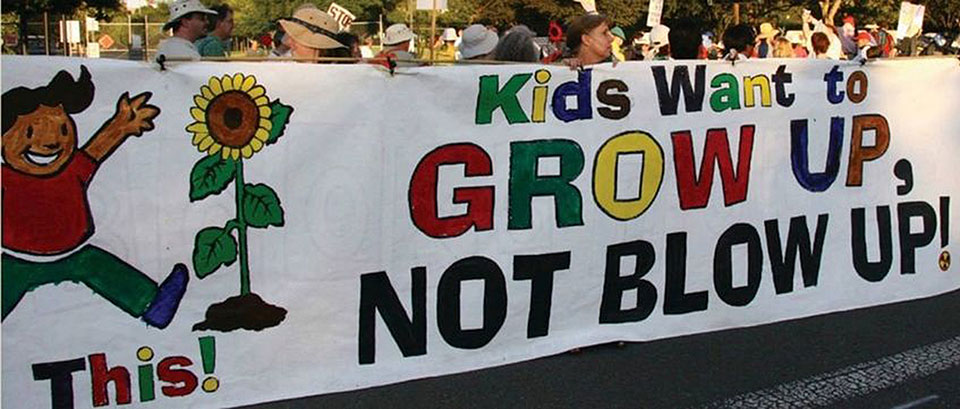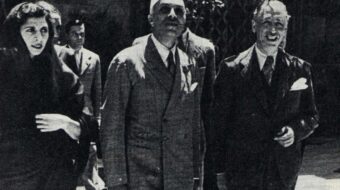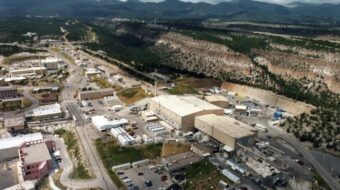
LIVERMORE, Calif.—This year, at the gates of Lawrence Livermore National Laboratory, commemoration of the solemn 76th anniversaries of the U.S.’ nuclear devastation of two Japanese cities, Hiroshima and Nagasaki, during World War II linked together two existential threats all humanity faces today: the escalating development of new, ever-more lethal nuclear weapons and the rapidly accelerating consequences of climate change.
The theme of the hybrid in-person and virtual gathering — Nuclear Weapons & Climate Change: Shine a Light, Stop the Hate, Lower the Heat — highlighted the paths to avert disaster as well as the rapidly intensifying threats.
Opening the program, Marylia Kelley, executive director of the Livermore-based Tri-Valley Communities Against a Radioactive Environment (Tri-Valley CAREs), told participants that President Biden, in his first budget request to Congress, is proposing to fully fund the continued development of all the new warheads former president Donald Trump had included in his Nuclear Posture Review.
With more than 85% of its Department of Energy funding earmarked for nuclear weapons activities, Kelley said, Livermore Lab — one of two locations designing every new nuclear warhead and bomb in the U.S. stockpile — plays a central role in enabling today’s arms race.
Kelley listed five new weapons the lab is developing:
- The W80-4 warhead, for a so-called “long-range standoff” weapon to enable pilots to launch a sneak attack with a precisely guided, radar-evading nuclear weapon from thousands of miles away.
- The W87-1, “the first wholly new warhead design” since the announced end of the Cold War over 30 years ago.
- The W93, a new-design warhead for use on U.S. and United Kingdom submarines.
- The B-61-12, a new nuclear bomb intended for “forward deployment” at NATO bases.
- The W80-4ALT-SLCM, a modification of the W80-4 warhead for a new weapon, the Sea-Launched Cruise Missile.
Overall, she said, “as we as a country debate funding for human needs and infrastructure, we are poised to spend $2 trillion on new warheads, bomb plants to build them, and delivery systems to use them” over the next 30 years.
Meanwhile, over many years, Livermore Lab has released over a million curies of radiation into the atmosphere from its main facility and its experimental explosive test Site 300, and both lab employees and children in the Livermore area have experienced high levels of cancers and other radiation-linked illnesses.
Kelley urged all participants to join in “effective actions to change the future” including pressing their members of Congress to slash funding for nuclear weapons, joining protests at nuclear weapons sites, and “other creative nonviolent actions” to put a stop to the U.S. government’s role in developing and producing nuclear weapons.
The Reverend Nobuaki Hanaoka, a retired Bay Area Methodist minister who as an infant was living with his family near Nagasaki on Aug. 9, 1945, described the horrific impact of the weapons used to devastate the two Japanese cities.
Though his family did not experience the violent shock waves and enormous fireball that incinerated the city, his mother and sister both died of leukemia and his brother died of premature aging associated with radiation exposure.
A quarter of a million people died as a result of the bombings of Hiroshima and Nagasaki, Hanaoka said, but “today’s nuclear bombs are designed to kill billions and to cause a nuclear winter around the globe.”
Though in 2017 the United Nations General Assembly passed the Treaty on the Prohibition of Nuclear Weapons and the treaty entered into force in January, “the nine nations that already have nuclear weapons, including the U.S., Russia, and China, have so far ignored the treaty” and are maintaining their nuclear programs.
Hanaoka has written to President Biden, urging him to convene a conference of the nine nations to start discussing the dismantling of all nuclear weapons.
John Burroughs, senior analyst with the Lawyers Committee on Nuclear Policy, discussed the treaty in the context of legal documents dating back to the United Nations Charter that have found the threat or use of nuclear weapons violates international law.
Though the U.S. and the other nuclear-armed countries didn’t participate in negotiating the TPNW, and the U.S., UK, France, Russia, and China have jointly declared their opposition, Burroughs called the treaty “a strong and visible declaration of the illegality for all states of the threat and use of nuclear weapons.”
But, he said, while the document sets out a general framework for the global elimination of nuclear arms, it “lacks the specificity, targets and timelines set out in the Paris Agreement on climate change. It is imperative to create an effective process for global nuclear disarmament paralleling that for climate protection. And it is imperative to actually accomplish, in both the nuclear and climate spheres, the safeguarding of the earth and civilization for future generations.”
In a gripping account linking the two crises, Marcina Langrine and Benetick Kabua Maddison of the Marshallese Educational Initiative described the devastation of their ancestral Marshall Islands home by radiation from 67 nuclear weapons tests conducted on the archipelago’s Bikini and Enewetak Atolls between 1946 and 1958, including the massive Castle Bravo test in 1954, with disastrous health and economic consequences that continue today.
Maddison described how the radioactive debris left behind on Enewetak Atoll, where most U.S. nuclear tests took place, was concentrated under the Runit Dome, a huge structure created in the 1970s by U.S. military personnel sent to “clean up” the immense accumulation of nuclear waste. Instead, he said, they pushed the waste into the dome and covered it with an 18-inch cap of concrete.
Now, with radiation leaking from the dome and sea levels rising because of climate change, the Runit Dome could be sunk into the ocean, further impacting an already devastated environment.
“We stand in solidarity with the people of Japan,” Maddison said. “We share a history that is horrific for our people. It is urgent that we continue to educate the world about the impact of nuclear weapons and why we shouldn’t have these weapons in the 21st century and beyond.”
Founding member of the Pacific Asian Nuclear-Free Peace Alliance Tsukuru Fors extended those concerns to the issue of nuclear power, citing the 2011 earthquake-triggered disaster at Japan’s Fukushima Daiichi Nuclear Power Plant and noting that area residents had been told lies both before and after the disaster “by capitalism and government who were desperate to keep the system at all costs.”
Fors also cited the profound environmental damage suffered by San Francisco’s Bay View-Hunters Point neighborhood after the area suffered radioactive contamination from the Navy’s nuclear defense laboratory and its facilities to clean ships exposed during nuclear weapons tests in the years after World War II.
Daniel Ellsberg, whose release of the “Pentagon Papers” helped speed the end of the Vietnam War, compared the positions taken by today’s nuclear-armed countries with those taken by the commanders of the ocean liner Titanic as the ship faced doom from icebergs more than a century ago.
“We as a species are on the Titanic,” he said. “And what is at stake is not just mutual destruction, let’s say, of the U.S. and Russia — horrific as that would be — but the annihilation of most of the species, a totally wicked gamble.”
Citing the Poor People’s Campaign’s Jubilee Platform program to end poverty, dismantle the military economy, and address the climate crisis, California PPC co-chair Nell Myhand called for cutting military spending “by at least $350 billion.” She reminded rally participants that in late May, U.S. Representatives Barbara Lee, D-Calif. and Pramila Jayapal, D-Wash., introduced the PPC-inspired Third Reconstruction Resolution to Fully Address Poverty from the Bottom Up, demanding an end to the “forever wars,” repealing existing authorizations for use of military force, and restoring Congress’ war powers including those over limited uses of force like air and drone strikes.
Jackie Cabasso, executive director of Western States Legal Foundation, called on all participants, in-person and virtual, to tell their representatives in Congress to cancel replacement of the U.S. nuclear arsenal and instead, spend those funds on human needs and the environment, and to press Congress to embrace the Ban treaty and work for a verifiable agreement to eliminate nuclear weapons worldwide. She urged support for the Third Reconstruction Resolution, calling it “a historic omnibus vision … to center the needs of the poor with moral laws and policies, including abolishing nuclear weapons and embracing a bold climate agenda.”
Also presenting were Bay Area singer/songwriter Betsy Rose; composer/song leader Benjamin Mertz; soprano saxophone soloist Francis Wong; and MCs Patricia St. Onge and Wilson Riles Jr.












Comments